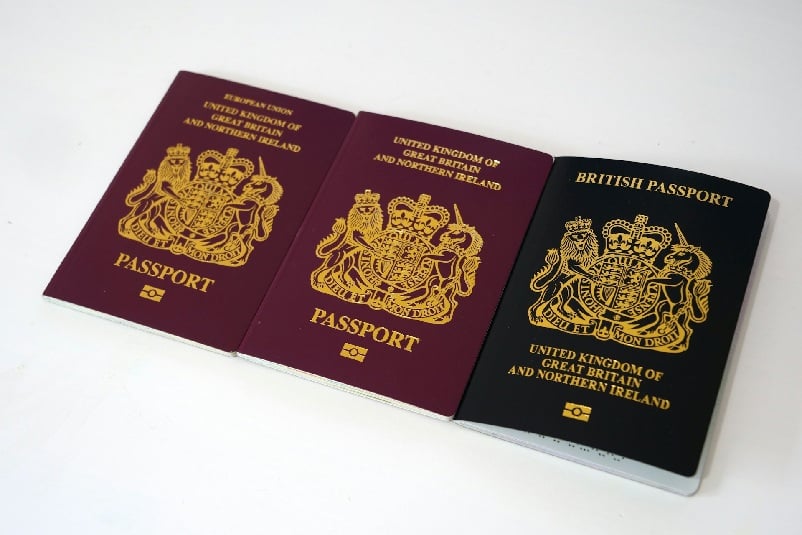What are the 20 Best Countries to Study Abroad? (Comparison)
This guide compares international immigration systems for student routes. We look at the key differences in costs, visa pathways and long-term residence permissions to help you decide where to move to as a student.
For expert advice on Student Visas, globally, as well as support with applying for visas, call us on +44 (0)333 414 9244 or reach out to us online.
Read our 1001 reviews
Best Countries to Study Abroad (comparing student options worldwide)
The best countries to study abroad are personal and based on key motivating factors These vary from person to person. We analyse some of the key reasons for people to study abroad and discuss the best countries to study in based on each reason.
What are the top reasons prospective international students factor in when choosing where to study?
There is a broad mix of reasons why students study abroad. The International Student Barometer (ISB) has captured key data on the student experience of over 4 million students. These are the core reasons they found:
- Strength of Academic Programs (94% said this mattered)
- Tuition Fees (86% said this mattered)
- Cost of Living & Proof of Finances Globally (87% said this mattered)
- Post-Grad Visa Pathways & Routes to Settlement Compared (66% said this mattered)
- Employability & Job Prospects Compared (96% said it matters to future prospects, and 77% said work opportunities mattered)
- Visa Difficulty Compared (81% said this mattered)
- Accessibility of Higher Education (84% said this mattered)
- Cultural Experience
Sources [ISB, EtioGlobal]

Ranking System
Based on popularity, we have chosen to compare 20 of the top countries to study in, globally. We rank our top picks in each category.
We make our verdict based on each category and align all categories at the end of the article to find a composite score. We use sources, data and information to make our decision on each category. You can also see the main factors that will help you choose the best country to study, for you personally.
It is important to note, that while some of the information is based on QS world rankings, education indexes and more, some is based on average cost comparisons and other factors, that make it a comparative study, and not an exact science.
Most Popular Countries for International Students
Choosing where you study can be based on the popularity and availability of international student programs. The US has the most international students, with over 950,000, while the UK is its closest rival, with 630,000 international students, representing nearly 1% of its population.
Regarding where international students come from, Asia and Africa dominate the countries that send the most international students, while Germany and France send significant numbers of students abroad to study.
Countries with the most international students (incoming)
- United States (over 950,000)
- United Kingdom (over 630,000)
- Australia (over 370,000)
- Germany (over 370,000)
- France (over 300,000)
- Canada (over 300,000)
- China (over 200,000)
Countries where most international students come from (sending)
- China
- India
- Nigeria
- South Korea
- Germany
- France
- Vietnam
Verdict: Top 3 countries for international students based on quantity of international students
- USA
- UK
- Australia
The United States is the clear winner in the international students’ popularity contest, the United Kingdom is the closest competitor, and Australia edged out Germany for third. Let’s examine this further to see if some of the top reasons people study abroad align with the popularity of those countries for international students.
Academic Programs at Top-Ranked Global Universities

It’s hardly a surprise when you look at the countries with the most international students that the UK and the US enjoy the best educational reputations in the world. That is why we’ve chosen the quality of academic programs next on our list.
Many choose to study abroad according to academic programs afforded to them at highly ranked global universities. Attracted by global reputations, faculty expertise, and state-of-the-art research facilities, students often choose academic programs based on rankings in their preferred specializations. We look into which countries rank best on the QS ranking system, and then some of the world’s top universities.
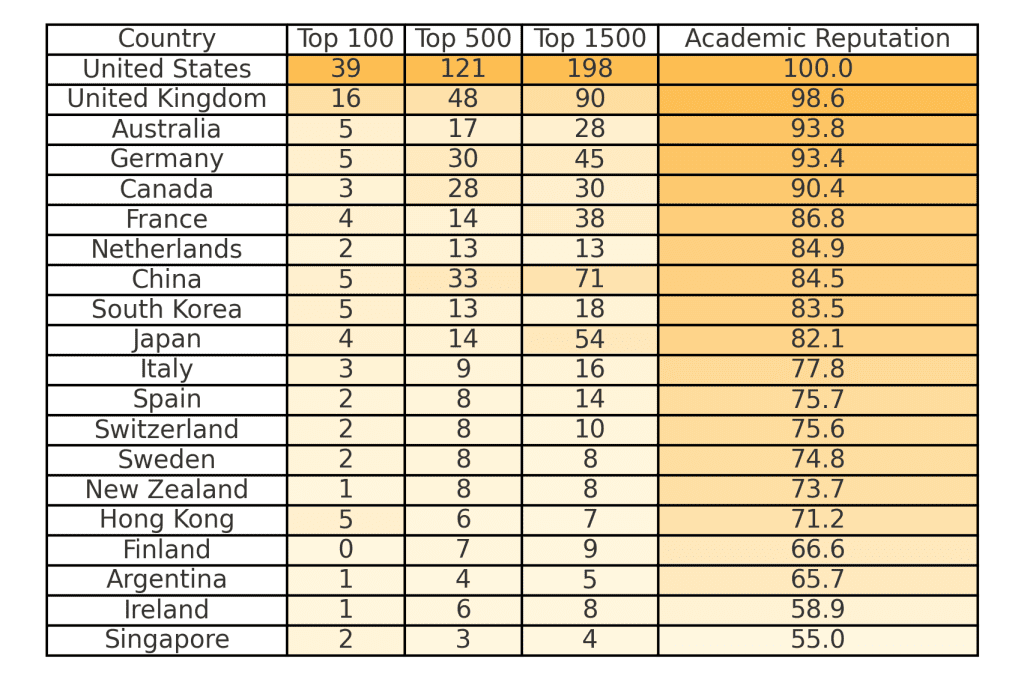
Source – QS Academic Reputation (AR) Indicator 2024
Comparison of Top Global Academic Programs by Country

The USA and the UK have the most universities in the QS top 10 global academic programs, with four universities listed apiece, with Singapore and Switzerland finalising the top 10. Outside of the top 10, world-class academic programs still cater to different specialist subjects. Universities are ranked by QS on the following criteria with the weightings of the decision in brackets:
- Academic reputation (30%)
- Employer reputation (15%)
- Citations per paper (10%)
- Papers per faculty (5%)
- International Research Network (10%)
- Employment Outcomes (5%)
- Faculty Student Ratio (5%)
- International Student Diversity (5%)
- International Faculty Ratio (5%)
- Inbound Student Ratio (2.5%)
- Outbound Exchange Student Ratio (2.5%)
- Sustainability Score (5%)
Source [QS]
Top Ranked Universities by Country (QS World Ranking)
“The point of a university is not to prepare students to be financially successful, but to find out for themselves a bigger purpose for their lives”.
Chancellor’s welcome address, University of Oxford
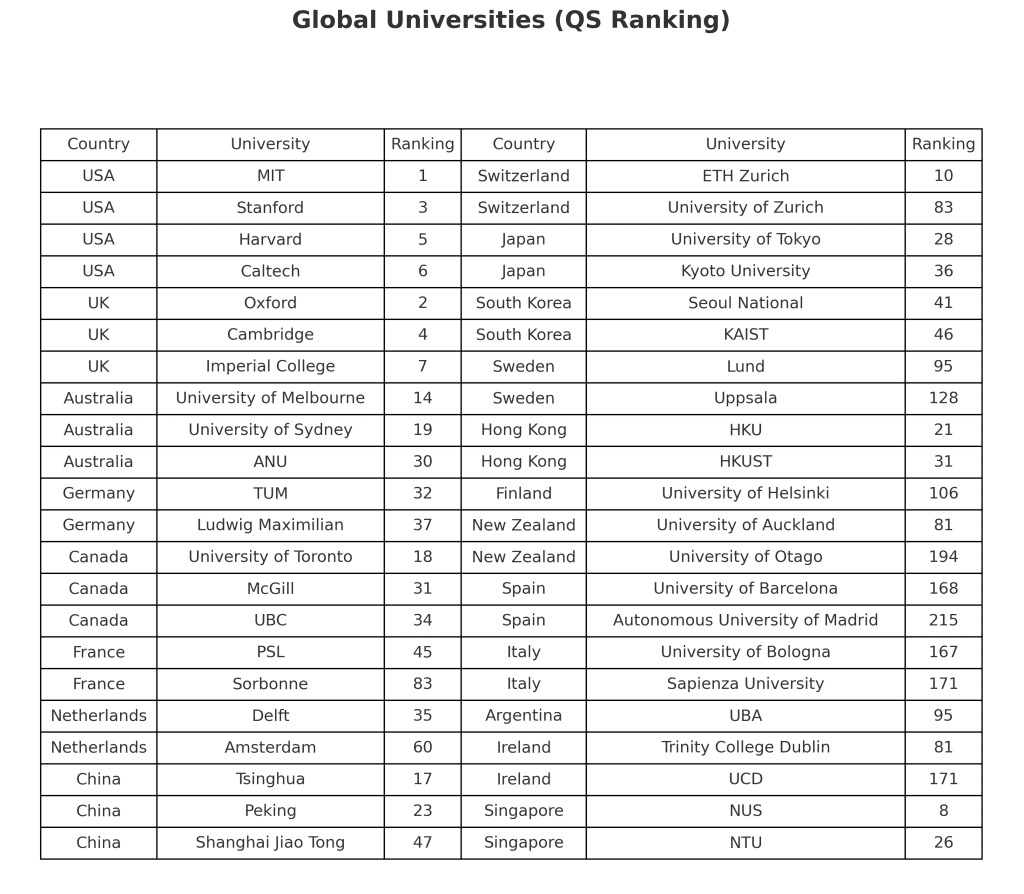
Source – QS World University Rankings
Verdict: Top 5 countries for international students based on quality of academic programs
- USA
- UK
- Australia
- Germany
- Canada
So far, everything aligns. The most popular countries have the best academic programs. Do they have the most diverse?
Program Diversity

The ‘Course Title’ is now the second-highest ranking reason for people choosing an educational institution replacing employability.
International Student Barometer (ISB), EtioGlobal
Given that the course title is an important factor in an international student’s deliberating process, it is important to factor in the programs of study in the field in which you plan to study. We have offered some insight into the key specializations of each country and ranked each by the diversity of the academic programs represented in the top 1500 universities in the QS rankings. This is as follows:
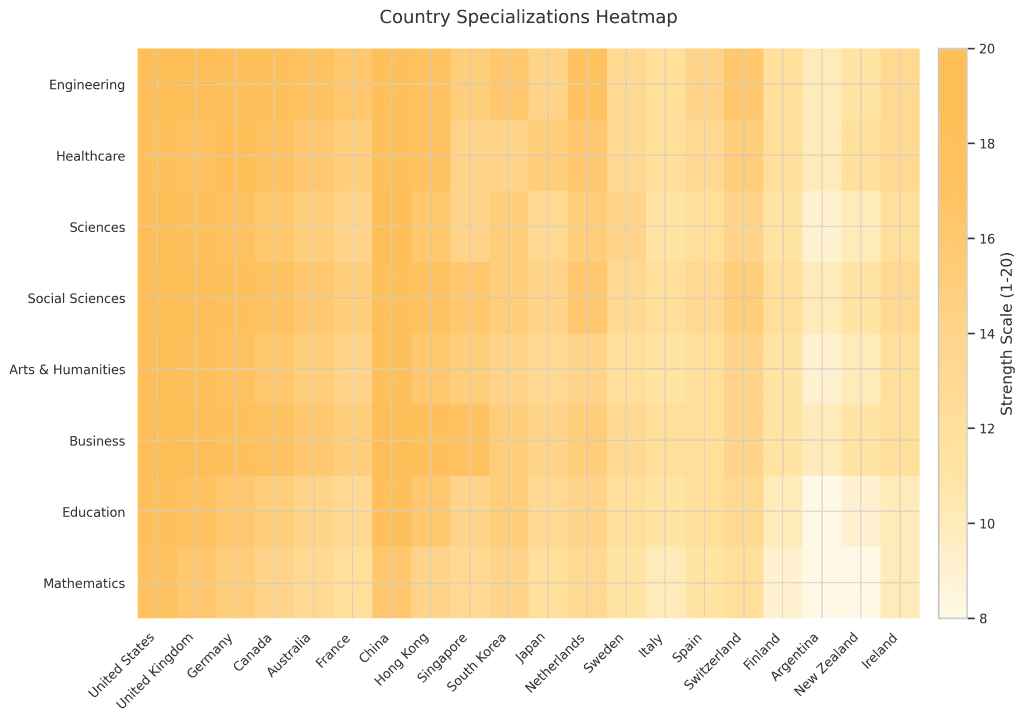
Sources – QS, OECD Better Life Index, ISB
Verdict: Top 5 countries for international students based on diversity of academic programs
- USA
- UK
- Germany
- Canada
- Australia
Diversity of programs is broadly consistent with each country’s academic ranking. Let’s look at other factors.
Some may stop at the educational indexes and isolate those metrics, which also offer insight into employment opportunities and development.
We want to dig into ground-floor, penny-pinching reasons, as well as overall experience, to determine our own framework, which is reusable and may help you make a decision on where the best place to move is.
Tuition Fees Comparison

Some European countries such as Germany offer free or low-cost education. The cost of education in the UK, North America, and Oceania is typically higher, while Europe offers more modest fees. Asia too is competitive in terms of fees, with most taking up the middle ground. Let’s break down estimated tuition fee costs in countries around the world.
Note, that Germany is not the only European nation to offer free tuition fees. Several European countries, including Germany, Sweden, Finland, and France, offer free or low-cost tuition for EEA/Swiss students. Non-EEA students face moderate fees in each of those, except Germany. Also, Norway, which does not appear in this study.
Can I afford to study abroad? 75% say tuition fees and cost of living or key to their decision on where to study. Fees are also the number one reason for turning down an offer of a university place
ICEF Monitor
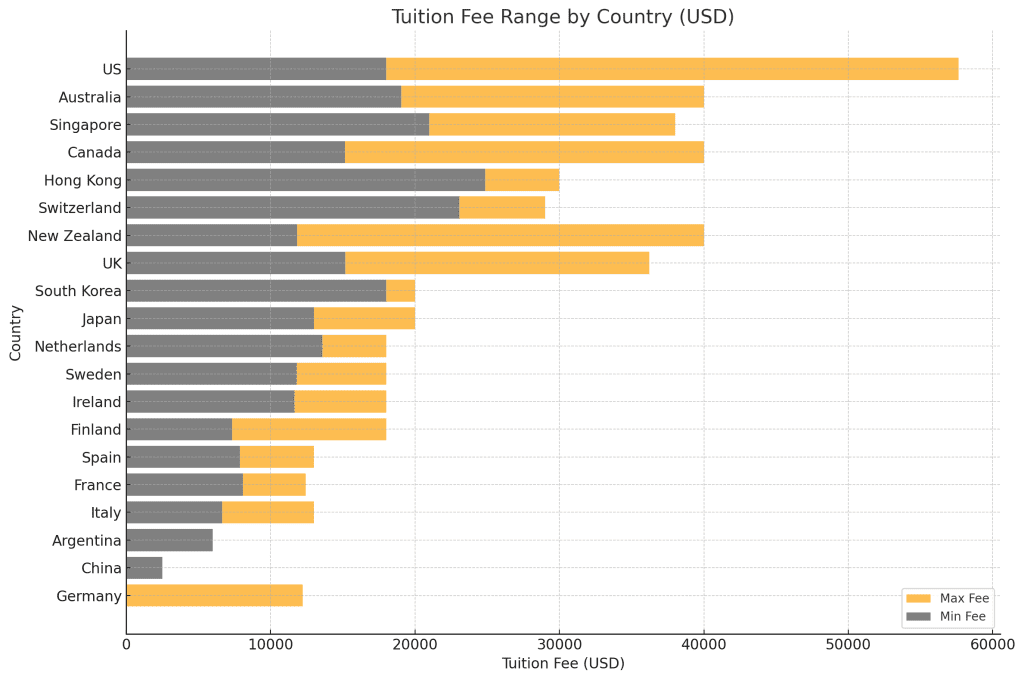
Verdict: Top 5 countries for international students based on tuition fees
- Germany
- Argentina
- France
- Italy
- Spain
Once more, the popularity contest gives clues as to another immigration factor for international students. Both France and Germany have universities in the top 50 internationally-ranked universities, which didn’t quite get them into the top 3 for academic programs, but for cost, it’s a different story. Combining the quality of academic programs with the cost of tuition means Germany and France are compelling options for international students.
Visa & Proof of Funds (Living Costs) Comparisons

51% of prospective international students are reconsidering studying abroad due to rising living expenses.
IDP (International Development Program)
The costs of obtaining a student visa can vary from place to place. It may not be the defining factor for most, as most student visas worldwide cap out at around $400. It may be the little costs that can rack up. For example, the UK and Australia charge a yearly healthcare surcharge payable per year for the duration of your study but allow free healthcare access. In contrast, others may require a health insurance policy, which can vary considerably in cost. Other costs can rack up, too, including student maintenance or student service access, which some countries require.
While those costs may not necessarily derail any of the nations from your thought process regarding your international education, proof of funds might.
Proof of funds is the evidence of your financial resources during your study. This is not payable; this is the money set aside to finance your stay. Each country has differing requirements on how much you need to be able to show. It typically relates to living costs in the country. It is a reasonable expectation of spending across a year in that country on things like accommodation, food, bills and living expenses.
We compare all the costs below, where all countries allow some work while studying, but pay particular attention to the Proof of Funds:
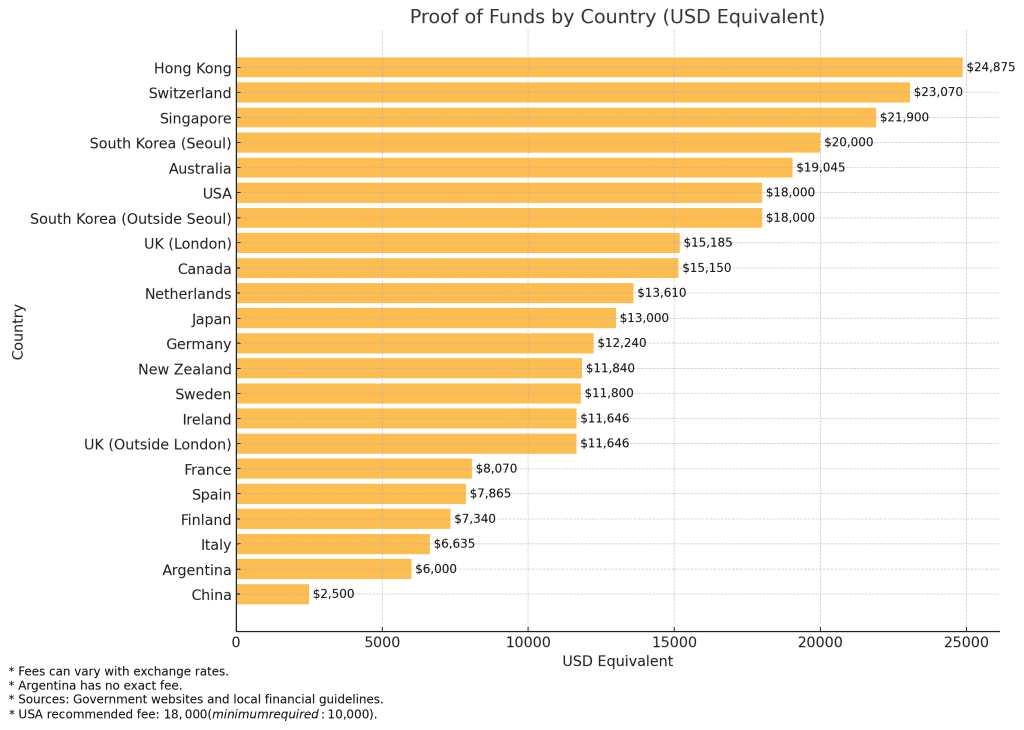
Other costs can include:
- Visa fees – typically ranging from €40 to €600
- Healthcare costs, which could include surcharges, insurance or private plans – typically range from €75 to around €1500.
- Additional costs that could include notarised, translated documents for visa processes, legal fees, medical exams, certificates (medical, police clearance), student maintenance/support contribution, books and study materials (budget €500-2500 depending)
- Living costs (typically use the proof of funds as a guide for how much you might need. Some cases, this does not reflect the cost of living, so read up on the price of groceries, accommodation, etc in the country you choose) – budget your proof of funds amount or €5000+ per year (whichever is higher)
Verdict: Top 5 countries for international students based on financial requirements (proof of finances)
- China
- Argentina
- Italy
- Spain
- Finland
There is not much variation in visa and healthcare fees here, so as stated, we look directly at proof of funds for this verdict. Germany actually compares well with Canada, Ireland and Singapore. It is cheaper than the UK, but as the financial proof comes in a blocked account, it adds a slight additional complication that might be undesirable to some who want to retain cash flow. However, combining the low tuition fees with a relatively low maintenance amount (proof of funds) Germany remains a great low-cost option for international students.
Post-graduation Routes Compared Worldwide

An International Student Barometer (ISB) study found permanent residency as a prime reason for choosing an institution, especially for students from the following countries:
International Student Barometer (ISB) study, EtioGlobal
- 79% of Indian students
- 88% of Nigerian students
- 79% of Pakistani students
- 74% of Chinese students
- 42% of Saudi students
Some international students place value on their routes to residence or citizenship as part of their decision-making process and aim to consolidate themselves in the country they choose to study, or at least want the option to.
Most countries offer a continuation pathway after graduation, with a Graduate Visa available in most nations, typically for 1-3 years after successfully completing your studies. After that, they offer differing pathways, typically requiring a skilled-employment visa or family visa to continue your stay, and offering a route to citizenship.
Table Comparing Postgraduation Options Worldwide
| Country | Graduate Visa Option | Work Permit Possibilities | Pathway to PR/Citizenship | Points |
|---|---|---|---|---|
| Canada | Post-Graduation Work Permit (PGWP) up to 3 years (typically equals the study period, up to 3 years) | Express Entry, PNP, High-skilled jobs, no salary threshold | PR after 1 year of work; Citizenship after 3 years of PR | 20 |
| Australia | Post-Study Graduate Visa (2-4 years) | Temporary Skill Shortage Visa, Employer Nomination Scheme | PR after 4 years; Citizenship after 4 years of residence | 19 |
| Ireland | Third Level Graduate Scheme (Stamp 1G) – 1 year for bachelor (Level 1), 2 years for Master/Doctorate (Level 9 or 10) | Critical Skills Employment Permit (salary threshold: €30,000/year) | PR after 5 years of work; Citizenship after 5 years | 18 |
| United Kingdom | Graduate Visa (2 years, or 3 with PhD) | Skilled Worker Visa (salary threshold: £38,700/year; £29,000 for health/care roles) | ILR after 5 years of work; Citizenship after 1 year of ILR | 17 |
| New Zealand | Post-Study Work Visa (1-3 years) | Skilled Migrant Category Visa, Employer sponsorship available | PR after 2 years of work; Citizenship after 5 years | 16 |
| Sweden | Post-Graduation Work Permit (up to 12 months) | Work Visa for skilled workers (no salary threshold specified) | PR after 4 years; Citizenship after 5 years | 15 |
| United States | Optional Practical Training program (OPT) – 1 year (2-3 in STEM) | H-1B Visa (minimum salary: $60,000/year), Employer-sponsored Green Card | PR through Green Card; Citizenship after 5 years | 14 |
| Germany | 18-month Job-Seeker Visa | EU Blue Card, Work Visa (salary threshold: €56,400/year; €44,304 in shortage sectors) | PR after 2-5 years; Citizenship after 8 years | 13 |
| France | APS (Up to 2 years) – 1 year, or 2 years for Masters degree or higher | Work permit for skilled or sponsored workers | PR after 5 years; Citizenship after 5 years | 12 |
| Netherlands | Orientation Year Visa (Zoekjaar) – 1 year | Highly Skilled Migrant Visa, EU Blue Card (minimum salary: €38,000/year) | PR after 5 years; Citizenship after 5 years | 11 |
| Italy | Post-Graduation Visa (up to 12 months) | Work permits for skilled workers (minimum salary: €24,000/year) | PR after 5 years; Citizenship after 10 years | 10 |
| Spain | Post-Graduation Visa (up to 1 year) | Work permits for skilled workers (minimum salary: €22,000/year) | PR after 5 years; Citizenship after 10 years | 9 |
| Japan | 1-year Job-Seeker Visa | Work Visa for skilled positions (minimum salary: ¥3 million/year) | PR after 5 years; Citizenship after 5 years of PR | 8 |
| Hong Kong | Post Graduation Visa (IANG) – 1 year to look for employment | Skilled work extension possible (no salary threshold specified) | PR after 7 years; Citizenship available but selective | 7 |
| South Korea | D-10 Job-Seeker Visa (6 months) | E-7 Visa for skilled workers (₩2.5 million/month) | PR after 5 years of work; Citizenship after 5 years of PR | 6 |
| Switzerland | Short-term permits for job-seeking | Requires employer sponsorship for work permits (minimum salary: CHF 120,000/year) | PR after 10 years; Citizenship after 12 years | 5 |
| Argentina | Temporary Residence for Work Search Visa (1 year) | Work visa with employer sponsorship (minimum salary: AR$1,500,000/year) | PR possible after 2 years; Citizenship after 2 years | 4 |
| Finland | 1-year Job-Seeker Visa | Work permit for skilled workers (minimum salary: €34,000/year) | PR after 4 years of work; Citizenship after 5 years | 3 |
| Singapore | 1-year Long-Term Visit Pass | Employment Pass (minimum salary: SGD 3,000/year for newly grads) | PR eligibility after several years; Citizenship selective | 2 |
| China | No specific post-graduate visa. You must job search on a student visa. | Z Visa (work visa) for skilled positions, requires job offer and company sponsorship | Limited PR pathways; Citizenship difficult for foreign nationals | 1 |
Verdict: Top 5 countries for international students based on Post-graduation Routes & Ease of Settlement
- Canada
- Australia
- Ireland
- UK
- New Zealand
Postgraduate routes are available in most countries, including graduate visas or alternatives. The difference that stands out in Canada, Ireland, Australia and the UK is the route to citizenship. Canada and Ireland offer relatively fast routes to residence and citizenship and are not such a challenging environment as other nations, including Australia and the UK. The latter two countries offer good options for staying in skilled roles as long as you earn salaries over £38,700 and £44,000, respectively, and have the required skills, experience, and qualifications for your job. Beyond that, there is a clear and distinct pathway to settlement.
Graduate Job Prospects

According to research, over 60% of students who study abroad report significant gains in critical career skills such as adaptability, intercultural understanding, and problem-solving.
Institute of International Education (IIE)
Job prospects are among the most critical reasons when considering where to study. Whether they plan to boost career prospects back home upon the completion of their degree or build a career in their host country, job prospects are central to decision-making. The Graduate Employability Index is a QS ranking system that accounts for students who move onto paid work within 15 months of graduation.
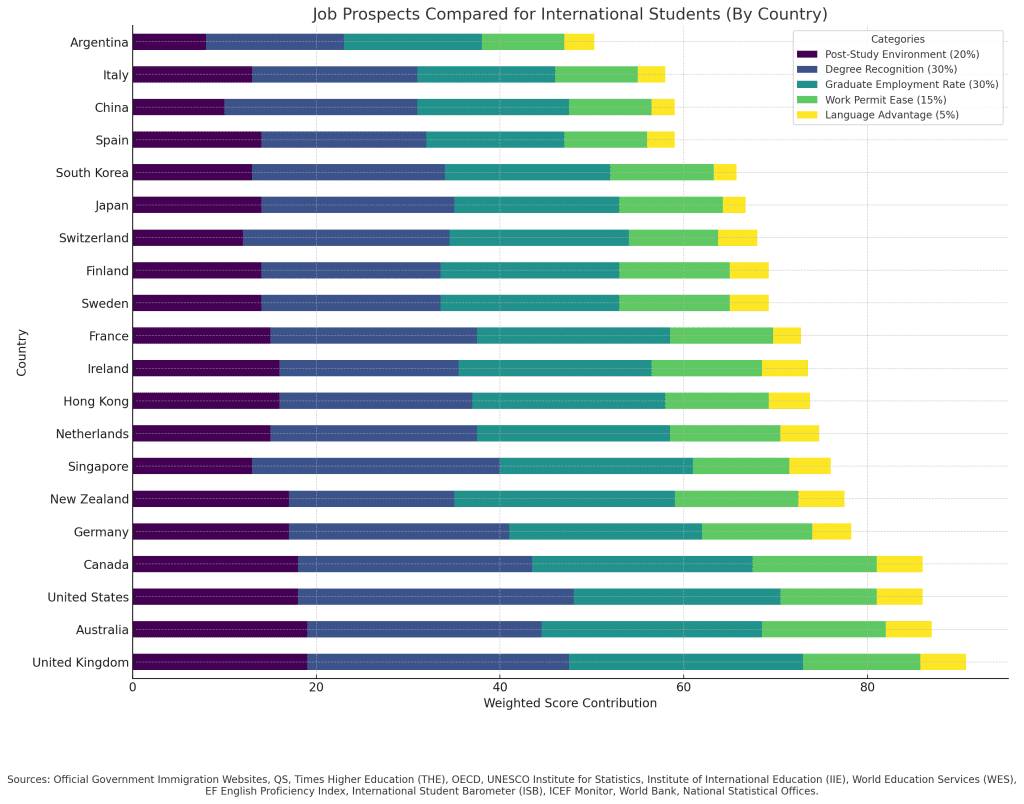
Verdict: Top 5 countries for international students based on job prospects
- US
- UK
- Germany
- Canada
- Australia
How Accessible is Each Country in terms of university places and visas for International Students?
Getting into an accredited university in any country can be challenging, with competition for places among the world’s elite rising. Beyond whether your academic potential and qualifications to this points stacks up to the competition, you need to contend with the number of international student places in each country. We look into estimates of how many international students they have already and the density of students in the general population to decide the most accessible countries.
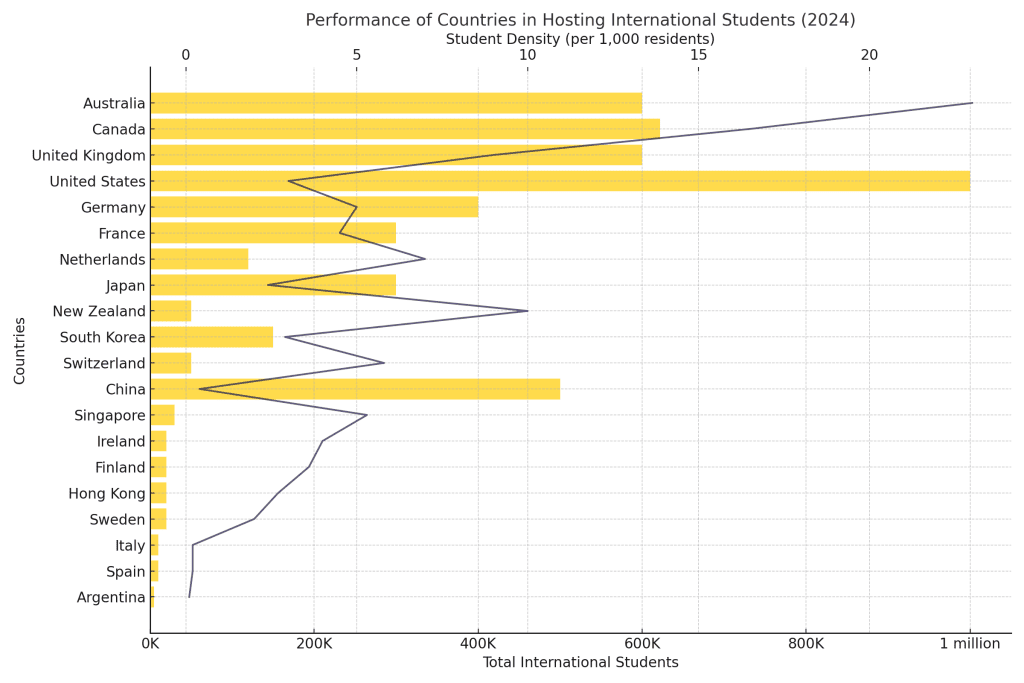
Verdict: Top 5 countries for international students based on accessibility of visas and university places
- Canada
- Australia
- USA
- UK
- Germany
How Challenging is the Student Visa Process?

81% of international students said the visa process factors into their decision of where to study abroad
ISB, EtioGlobal
Visa processes can be hard to understand with different eligibility requirements for each country, as well as differences in what you need to prove when applying for a visa. The processing times also vary from country to country. Most student visa processes are not as difficult as other visa processes (like work and family visas) as long as you can prove:
- You have been offered a place at an accredited higher education (HE) provider in that country
- You can support yourself, or can prove funds from others to support yourself while you study
- You complete all application forms correctly, truthfully and don’t omit important information
| Country | Difficulty Factors | Points |
|---|---|---|
| New Zealand | Moderate financial proof, English proficiency, health checks, generally accessible process with minimal requirements for students. | 20 |
| Singapore | Straightforward visa process, minimal barriers (financial proof, health checks, no interviews). Highly accessible. | 19 |
| South Korea | Moderate financial proof, enrollment, generally straightforward, no interviews, fewer barriers for international students. | 18 |
| Netherlands | Moderate financial requirements, housing and health insurance required, but overall streamlined for international students. | 17 |
| Germany | Moderate financial requirements (blocked account), but the process is generally efficient for international students. | 16 |
| Finland | Financial proof, housing proof, health insurance, and background checks required; overall efficient, especially for EU students. | 15 |
| Hong Kong | Moderate financial proof, health checks, housing proof; overall less complicated than mainland China. | 14 |
| Ireland | Proof of funds, English proficiency, health insurance, and character checks; relatively simple process with fewer hurdles. | 13 |
| Canada | Proof of funds, SOP, medical checks, and extensive documentation; interviews may be required, but manageable overall. | 12 |
| Sweden | Financial proof, enrollment, health insurance; streamlined process for EU students but a bit more paperwork for non-EU students. | 11 |
| Switzerland | Simple for EU students, but non-EU students face higher financial requirements and stricter immigration rules. | 10 |
| Australia | High financial requirements, GTE requirement, health and character checks, complex documentation, and interviews. | 9 |
| United Kingdom | High financial requirements, mandatory English tests, interview screenings, and detailed documentation. | 8 |
| United States | Strict security checks, mandatory interviews, extensive documentation, financial proof, and ties to home country. Complex and lengthy process for students. | 7 |
| France | Multiple steps (interviews, financial proof, health insurance), more complicated for non-EU students, but manageable. | 6 |
| Spain | Moderate documentation, financial proof, health insurance, and no interviews. Straightforward for students but a bit more paperwork. | 5 |
| Italy | Moderate financial proof, health insurance, proof of accommodation, and no interviews, but still requires more documentation than some others. | 4 |
| Argentina | Moderate financial proof, health checks, minimal documentation required, no interviews, but the visa process can still be cumbersome. | 3 |
| Japan | Requires financial proof, health exams, documentation; long wait times for permanent residency, and somewhat complex visa durations. | 2 |
| China | Strict financial proof, health exams, difficult process, long wait times for residency, and complex eligibility criteria. | 1 |
Verdict: Top 5 countries for international students based on student visa processes
- New Zealand
- Singapore
- South Korea
- Netherlands
- Germany
Student Experience

“One’s destination is never a place but a new way of seeing things”
Henry Miller
Student experience is a driving factor for many students when choosing where they plan to study. We’ve combined student experience with cultural experience, Human Development Indicator (HDI), and Student Satisfaction.
| Country | Student Experience (ISB) | Quality of Living (Mercer) | HDI Score (UN HDI) | Student Satisfaction (ISB) | Points |
|---|---|---|---|---|---|
| Switzerland | 4.7 | 4.8 | 0.967 | 4.39 | 20 |
| New Zealand | 4.7 | 4.8 | 0.939 | 4.18 | 19 |
| Sweden | 4.5 | 4.5 | 0.952 | 4.15 | 18 |
| United States | 4.6 | 4.8 | 0.927 | 4.32 | 17 |
| Germany | 4.4 | 4.5 | 0.950 | 4.36 | 16 |
| Canada | 4.5 | 4.7 | 0.935 | 4.11 | 16 |
| Finland | 4.5 | 4.5 | 0.942 | 4.31 | 15 |
| United Kingdom | 4.5 | 4.5 | 0.929 | 4.18 | 14 |
| Australia | 4.4 | 4.6 | 0.951 | 4.13 | 13 |
| Netherlands | 4.4 | 4.5 | 0.946 | 4.12 | 12 |
| France | 4.3 | 4.6 | 0.910 | 4.22 | 11 |
| Ireland | 4.4 | 4.5 | 0.955 | 4.19 | 10 |
| Singapore | 4.3 | 4.4 | 0.949 | 4.16 | 9 |
| South Korea | 4.3 | 4.5 | 0.929 | 4.10 | 9 |
| Japan | 4.2 | 4.3 | 0.920 | 4.26 | 8 |
| Hong Kong | 4.1 | 4.3 | 0.956 | 4.17 | 7 |
| Spain | 4.3 | 4.5 | 0.904 | 4.22 | 6 |
| Italy | 4.3 | 4.5 | 0.888 | 4.27 | 5 |
| Argentina | 4.1 | 4.2 | 0.845 | 4.16 | 4 |
| China | 3.8 | 4.2 | 0.788 | 4.04 | 3 |
Sources include ISB, United Nations Development Programme (UNDP) and Mercer Quality of Life Index used to define a points-based system factoring in a well-rounded student experience.
Verdict: Top 5 countries for international students based on student experience
- Switzerland
- New Zealand
- Sweden
- USA
- Germany
Based on Safety

Safety has become the leading factor for international students when selecting where they study abroad
– ISB, EtioGlobal
Some are surprised to learn that safety ranked as the number one reason students looked at when choosing where to study. In an ISB study, it was revealed to have replaced Employability as the top reason in 2024. We look at the Global Peace Index to see how our 20 countries are viewed in terms of peace, safety and security.
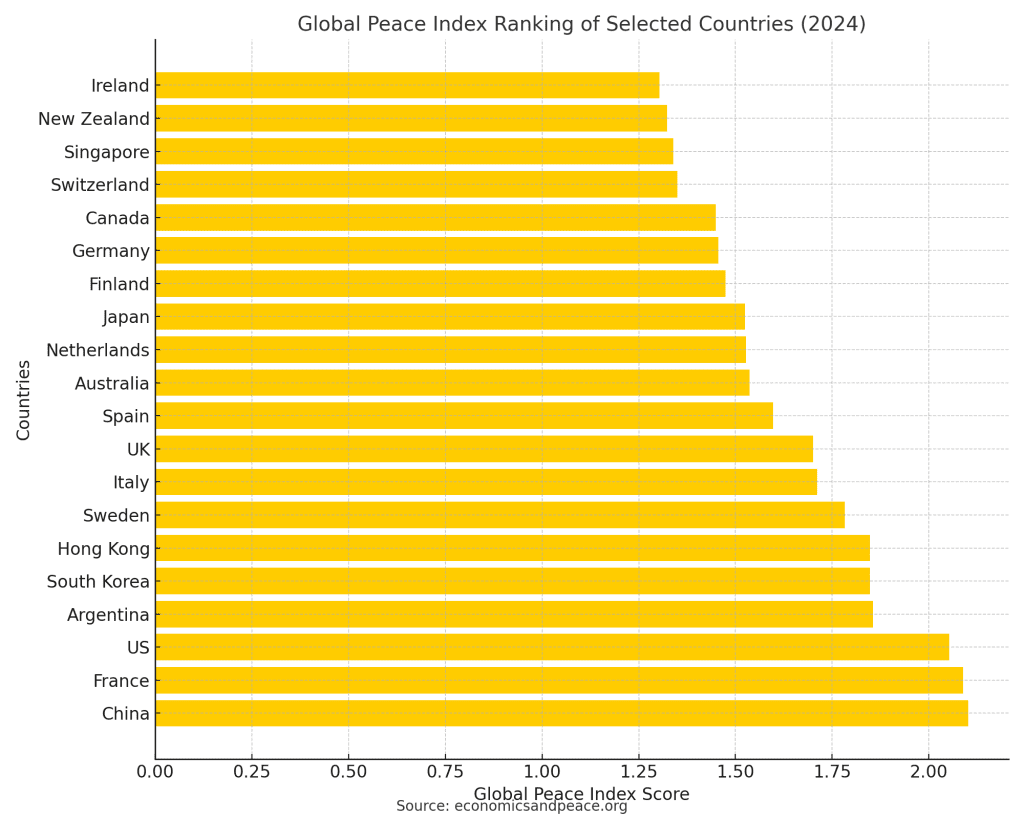
Source: economicsandpeace.org
Verdict: Top 5 countries for international students based on safety
- Switzerland
- New Zealand
- Finland
- Singapore
- Canada
Adaptability, language barriers & student support

Findings indicate that 80% of students manage the process of transition successfully it
University of Huddersfield study
still means that approximately 20% of students are failing to come to terms with the academic and social
demands of university life
Universities should be about learning and challenging yourself, but some challenges command greater support, like assimilating into a new country, homesickness, stress, and anxiety. Language barriers can be an additional obstacle, both in academic and social circles and in day-to-day life. Most countries, particularly in the major city hubs offer English-speaking tuition on many courses, while others have fewer, and in some the language barrier is much more noticeable. We look into adapting to a host country and some of the support systems in place.
| Australia | English-speaking, minimal language barriers. Excellent student support services, including mental health programs and welfare initiatives. The culture welcomes international students, and assimilation is easy for most. Universities are proactive in providing mental health resources and counselling services. |
| United Kingdom | English is spoken in all universities, barring some courses with Welsh or Gaelic instruction in Wales or Northern Ireland. Some regional accents and dialects are a little tricky at times. International student networks are well established, and so are excellent student services. Universities provide strong mental health support to students. |
| Canada | English and French are spoken, making it highly accessible for international students. Canada is known for being incredibly student-friendly, offering excellent support and welfare services, including comprehensive mental health initiatives. It is very welcoming, offering strong cultural adaptability and support. Universities actively promote mental wellness and provide ample resources for students in need. |
| United States | All universities function in English, have abundant student services, and provide strong support systems for International students. Most institutions provide good mental health resources. Cultural assimilation is usually straightforward, especially in major cities; however, some more rural places offer a less favourable view of immigration. |
| Sweden | Sweden’s universities have high English proficiency, and most courses are offered in English. They also offer excellent student welfare services and programs, including solid university mental health support. Cultural adaptability is high, especially in a student-focused environment and open-minded culture. Sweden’s universities strongly focus on mental health services, ensuring students can access counselling and psychological support. |
| New Zealand | English-speaking with a relaxed, welcoming culture. Excellent student support, especially for those involved in outdoor activities. Mental health services are readily available within universities. International students often feel at home in a laid-back environment, making cultural adaptability relatively high. The country’s focus on student welfare and mental health support is a strong point. |
| Singapore | Although English is widely spoken, international students may face fierce competition. Universities have excellent student support services and welfare programs, including counselling for mental health, making adapting straightforward in most cases. However, due to its competitiveness, some may find it challenging to fit in. |
| Netherlands | English is widely spoken, particularly in academic settings. Student services are vital in significant cities, with universities offering extensive support. Universities provide mental health support, but it may not be as robust outside large cities. The focus is more on academics, and some cultural barriers may exist outside university life, but overall adaptability is moderate. |
| Ireland | Ireland is English-speaking, which makes communication easier. There are strong student welfare services and government support for international students, including mental health support at universities. Ireland is welcoming, though students outside major cities may find it a little harder to adapt to the local culture. Mental health services in universities are strong, with a growing emphasis on student well-being. |
| Germany | English is standard in some academic settings, but German is the primary language in daily life. Student services are robust, and universities offer mental health support services. Although mental health services are available, international students might face challenges accessing them in Germany. The student culture is supportive, though cultural adaptability can be more challenging outside university environments. |
| France | French is the primary language, which can be a barrier in everyday life, but universities offer English-language support. Student services are good, especially in major cities, with mental health resources at most universities. Cultural adaptability can be challenging due to the language and social norms, though international students can find communities in large cities. Universities have essential mental health services, but it may not be as accessible in smaller towns. |
| Finland | Finland has strong student support services at universities, including mental health resources. It is student-friendly, with a relaxed atmosphere typically on campus, and many courses are offered in English. However, outside the classroom, students could encounter challenges in cultural integration, particularly in rural areas. |
| Switzerland | It is a multilingual country (German, French, Italian), which can pose a challenge depending on the region. Excellent student support services and universities are vital in offering mental health support. The diverse culture requires adjustment depending on the region, and while mental health services are robust, international students may need time to adapt to the regional differences. |
| Japan | Japanese is the primary language, and while universities offer English support, the broader cultural environment can be a barrier. Student services are improving, but language remains a challenge. Mental health support exists but is still not as ingrained in the culture as in Western countries. Cultural adaptability is moderate, and international students may struggle to blend in socially. |
| Hong Kong | Cantonese and Mandarin are the primary languages, though English is widely used in universities. While student services are good, cultural adaptability can be more difficult, particularly for students unfamiliar with Chinese culture. Mental health resources are available but might not be as prevalent or promoted as in Western universities. |
| South Korea | The primary language is Korean, and English is not commonly used daily. The government and universities are improving the education system for students. Still, it can be difficult for foreign students to adjust to cultural differences because of the language barrier and local traditions. However, more expats are coming to South Korea. Mental health services exist but might not be as straightforward for international students, particularly in smaller towns. |
| China | Mandarin is the primary language spoken in China, while English is not taught much in rural areas within higher education institutions. Private universities, particularly with English subsidiary universities, offer tuition in English. Student services, including mental health programs, are being developed further. However, they’re still less strong than Western countries, making it harder for students who are not in elite universities in China to endure this transition. |
| Spain | Spain has a vibrant culture, and although Spanish is the primary language, universities offer courses in English, particularly in major cities. Student services and support programs are available, but language can still be a barrier. Mental health services are available but not as ingrained in the student culture as in some other countries. Cultural adaptability is moderate, especially outside larger cities. |
| Italy | Italy’s primary language is Italian, though many universities offer programs in English, especially in major cities. Student services are available, and mental health resources are growing in prominence. While Italy is generally welcoming, cultural differences can be more pronounced in smaller towns, and international students may face more challenges when it comes to assimilation. |
| Argentina | Argentina offers Spanish-language instruction, and English programs are available in some universities. While international students are welcomed, language can be a barrier in everyday life. Mental health support is still developing, and cultural adaptability can be a challenge for students who aren’t familiar with Latin American cultures. |
Verdict: Top 5 countries for international students based on adaptability
- Australia
- UK
- Canada
- USA
- Sweden
What the experts say

“Numbers and statistics aside, what makes a great student city? Before London, I studied in Aarhus, Toronto (#26) and Sydney (#6), thereby gaining varied perspective on the features of a great student city. In my opinion, here are the top four things that a city must have to be a world-class student city: Culture and character, Good public transport, Affordability, Cool hangout spots.”
Roop Gill, in Verge Magazine
From listicles to news articles, and popular opinion to academic circles, we look into the countries people are talking about online, in-person, and in print. What do the experts say is the best country to study abroad?
It’s important to remember that everyone thinks differently, and you must decipher your own reasons for moving.
| United States | Dominates global rankings from QS and The Student for its top universities, diverse academic programs, and strong international student networks. Regularly featured in NYT, The Atlantic, and HuffPost | 20 |
| United Kingdom | Highly visible in publications like Times Higher Education and QS. Featured in The Guardian and BBC for its cultural impact, prestigious universities, and strong post-study work opportunities. | 19 |
| Australia | Highly recommended in the Times Higher Education. Often highlighted in student blogs and platforms like The Student Room | 18 |
| Canada | Ranked in QS, The Globe and Mail for its student-friendly environment, diverse campuses, and post-study opportunities. Frequently mentioned in HuffPost for quality of life. | 17 |
| Germany | Featured in QS, as well as blogs and vlogs for its no-tuition fees and focus on STEM fields. Highlighted in international blogs like The PIE News | 16 |
| Netherlands | Consistently listed in QS and Times Higher Education for its high-quality English-taught programs. Frequently cited in The Huffington Post. | 15 |
| Japan | Appears in QS, and international student blogs and vlogs for its expanding tech and business programs. | 14 |
| France | Regularly featured in QS and publications for its rich culture, world-class institutions, and programs in business, fashion, and arts. Highlighted in publications like Le Monde and The Local | 13 |
| South Korea | Ranked in many blogs for its booming tech sector and student services. Frequently mentioned in The New York Times for its growing reputation in higher education, particularly in STEM. | 12 |
| Singapore | Cited in multiple online posts for its world-leading education system, Featured in Forbes and Business Insider for its rise as a global educational hub in Asia. | 11 |
| Sweden | Often listed in blogs and vlogs on studying abroad, for its innovative programs in sustainability and technology. Mentioned in The Guardian and The Local for its progressive education system | 10 |
| Switzerland | Frequent mentions in business and finance rankings, including QS, for its world-class universities and strong economy. Covered in publications like The Financial Times. | 9 |
| Ireland | Highlighted in multiple publications for English-speaking environment, and student-friendly policies, as well as growing international student community. | 8 |
| Hong Kong | Appears in global media for its rising profile as an educational hub in Asia for its global business sector, top universities, and diverse academic offerings. | 7 |
| China | Increasingly visible in international student blogs for its affordable education and expanding programs. Mentioned in publications like The Global Times for its developing academic reputation. | 6 |
| Spain | Frequently listed in blogs and publications like The Huffington Post for its welcoming environment and vibrant international student scene. | 5 |
| Italy | Often highlighted in The Guardian and Lonely Planet for attracting international students to its rich cultural landscape. | 4 |
| Argentina | Featured in international student blogs for its affordable education, vibrant culture, and emerging academic programs in business, humanities, and the sciences. | 3 |
| New Zealand | Ranked in QS and in blogs by publications like Lonely Planet for laid-back, student-focused environment, outdoor lifestyle, and demand for graduates in STEM and healthcare fields. | 2 |
| Finland | While often praised for its innovative education system with a cult following in niche student blogs, Finland is gaining recognition for its unique approach to student well-being and research. | 1 |
Verdict: Top 5 countries for international students based on expert/press opinion
- USA
- UK
- Australia
- Canada
- Germany
Overall Verdict
So, where is the best place to study abroad based on the main chosen factors for international students? Let’s take a look below at our combined and weighted scores.
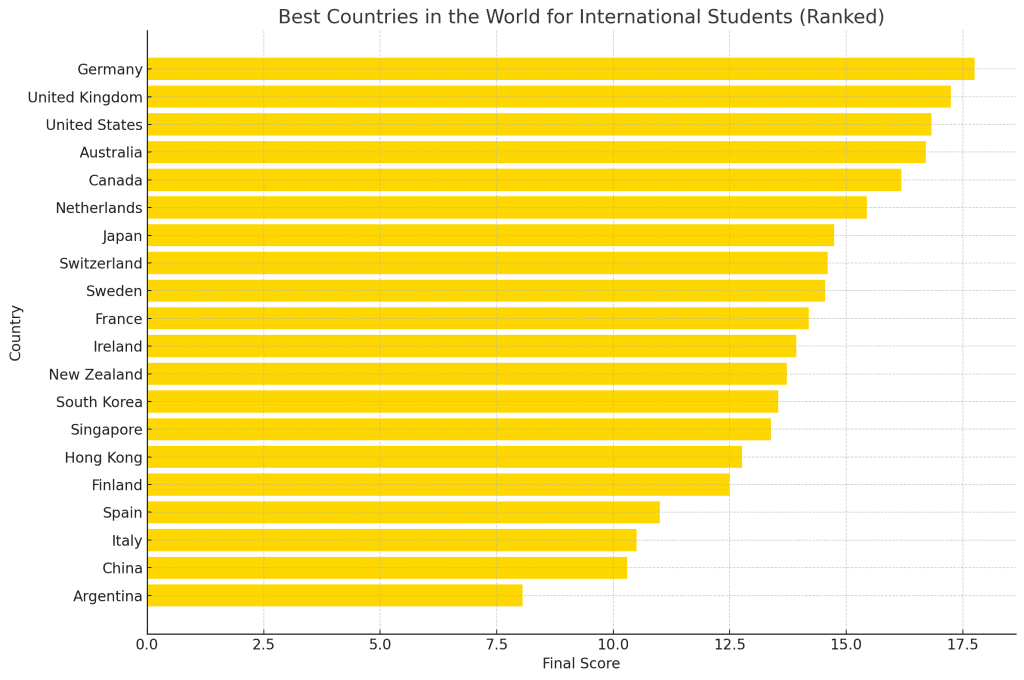
How We Ranked
Through our calculations and based on the reasoning given by students in ISB survey, mentioned at the beginning of the article, we have weighted our rankings as follows:
- Academia (12%)
- Safety (12%)
- Postgrad Pathways (10%)
- Employability (8%)
- Adaptability (10%)
- Student Experience (8%)
- Accessibility (8%)
- Expert Opinion (8%)
- Diversity of Course Programs (7%)
- Proof of Finances (7%)
- Tuition Fees (7%)
- Visa Process (5%)
Note, that this is a comparative study between the 20 countries mentioned, and if others were to be included, it might change the results.
Overall Winner – Germany

Germany wins when you account for each and every category we’ve compared. It’s low costs are complemented by good prospects, quality academic programs and a strong standard of living. Germany is the best choice overall for international students, in our study. But it’s important to give more emphasis on the factors that matter most to you.
Runner Up – UK & US
It’s fitting that these two come as something of a package. No one would dispute their academic prowess, and if that category means most to you, and you receive an offer from a top-ranking university in either nation, it is next to impossible for most to say no.
USA Vs UK – Studying Abroad


Outside of the high-ranking institutions there are great options, and some excellent academic programs, as well as a dynamic student culture. If cost is no obstacle, and in the case of the USA in particular, you plan to return home after your study, then the opportunities in either country maybe too good to miss.
The top 5 best countries to study abroad (based on our analysis of tuition fees, maintenance costs, quality of academia, popularity, prospects and routes to settlement)
It is impossible to accurately say the best educational experience for students unless you know what matters most to you. As we’ve said, it’s a personal journey to choosing where you study. However, we can say some things from this statistical analysis. So, what are the best countries to move to?
- Germany
- UK
- US
- Canada
- Australia
Europe’s Finest – Germany & Netherlands


Again, both Germany and The Netherlands offer excellent opportunities across the board, with high-ranking educational institutions, and low-cost study options. Both provide a good balance for international students. They may be a little more specialist-driven and geared more to short-term programs and Erasmus years than the UK and US mainly on account of potential language barriers, but they also offer a lot of programs with English as the primary instruction. A great choice for a quality, low-cost education. Sweden, France and Italy deserve a mention here too, for a strong performance across the board, only losing out on some metrics, particularly language barriers and cultural adaptability when it comes to the latter two, and Sweden walks the middle-ground in most metrics.
Asia’s Finest – Japan & South Korea


In our study, Japan and South Korea see off competition from China, Hong Kong, and even Singapore for education. It’s important not to discount the other three as they offer great education programs with fairly low costs, but these two edge it in Asia due to their consistency in multiple categories. China ranks lowly due to the complexity of visa processes, language barriers and other factors.
Honourable Mentions
Of course, there are many great programs globally, at universities in the Middle East, Africa, and South America also, as well as some in Europe that didn’t quite cut it on this one. But, let us know if you want us to analyze the pros and cons of other nations. Some honorable mentions include:
- Denmark
- Portugal
- Hungary
- Iceland
- Austria
- Brazil
- Peru
- Chile
- Costa Rica
- Turkey
- UAE
- South Africa
- Egypt
What matters most to you?
Let’s look at the table again and adjust the rankings based on your main motivating factors. You can omit any of the categories from your decision-making if you wish. But here, you can add extra points for the top 5 in the category that is most important to you.
For example, if academia is the most important thing to you, you can award more points in addition to what’s in the table.
You can do this for the top motivating factors to you. You could also change the scores and only award them to the top 1, 2 or 3. It’s entirely up to you and a base from which to work to determine the best place for YOU to study abroad.
Decide For Yourself – What is the Best Country to Study Abroad?
Table of Contents
Table of Contents will appear here.Legal Disclaimer
The information provided is for general informational purposes only and does not constitute legal advice. While we make every effort to ensure accuracy, the law may change, and the information may not reflect the most current legal developments. No warranty is given regarding the accuracy or completeness of the information, and we do not accept liability in such cases. We recommend consulting with a qualified lawyer at Immigration Advice Service before making any decisions based on the content provided.










